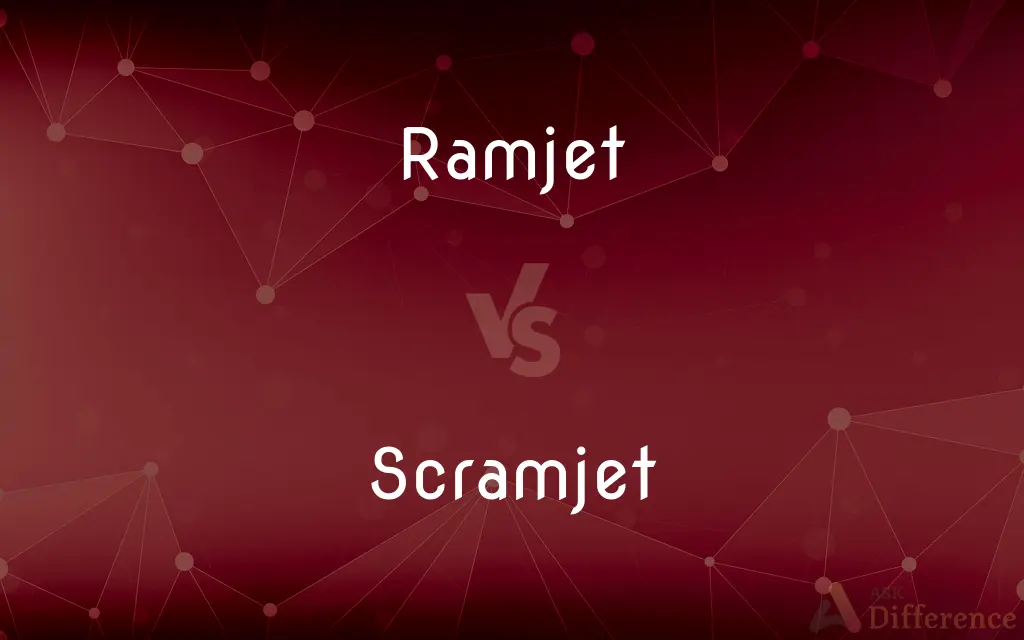Ramjet vs. Scramjet — What's the Difference?
By Tayyaba Rehman — Updated on October 26, 2023
Ramjet uses subsonic combustion while Scramjet utilizes supersonic combustion. Ramjet is effective at slower speeds, while Scramjet operates best at hypersonic speeds.

Difference Between Ramjet and Scramjet
Table of Contents
ADVERTISEMENT
Key Differences
Ramjet is an air-breathing jet engine that works by taking in air, compressing it, and then combusting it with fuel. The hot gases produced are expelled out, propelling the vehicle forward. The principle behind its operation is the ram effect, where the forward motion of the engine compresses the incoming air. Scramjet, on the other hand, stands for Supersonic Combustion Ramjet and, as the name implies, deals with supersonic combustion.
In the case of a Ramjet, the incoming air is slowed down to subsonic speeds before combustion. This allows the engine to operate efficiently at speeds from Mach 0.5 to around Mach 3. Scramjet, conversely, allows the incoming air to maintain its supersonic speed throughout the combustion process.
A key difference is that the Ramjet has a clear distinction between the compression, combustion, and exhaust sections of the engine. Scramjet, due to its design and the speed at which it operates, blends these sections together, making for a more integrated flow.
The Ramjet is simpler in design compared to the Scramjet, largely because slowing the air to subsonic speeds for combustion is less technologically challenging. Scramjets are more complex due to the difficulties associated with achieving stable supersonic combustion.
While both Ramjet and Scramjet engines have potential for high-speed flight, they serve different regimes. Ramjet is ideal for speeds up to Mach 3, while Scramjet is tailored for hypersonic speeds, typically above Mach 5.
ADVERTISEMENT
Comparison Chart
Combustion Speed
Subsonic
Supersonic
Operating Speed Range
Mach 0.5 to Mach 3
Typically above Mach 5
Design Complexity
Simpler with distinct engine sections
More integrated and complex
Airflow Deceleration
Reduces incoming air to subsonic speeds
Maintains supersonic airflow
Potential Use
High-speed missiles, aircrafts below Mach 3
Hypersonic vehicles and missiles
Compare with Definitions
Ramjet
A jet propulsion engine that utilizes the ram effect for air compression.
The missile utilized a Ramjet for its high-speed pursuits.
Scramjet
A variant of jet propulsion operating with supersonic combustion.
The experimental vehicle soared using a Scramjet, reaching hypersonic speeds.
Ramjet
An engine with a straightforward design slowing air to subsonic speeds for combustion.
Engineers appreciate the Ramjet's simplicity when addressing maintenance needs.
Scramjet
An engine designed for hypersonic speeds, typically above Mach 5.
The Scramjet's design is revolutionary, pushing the boundaries of speed.
Ramjet
A jet engine effective in the Mach 0.5 to Mach 3 speed range.
For aircraft operating between Mach 0.5 to 3, a Ramjet is a preferred choice.
Scramjet
A propulsion system maintaining supersonic airflow during combustion.
Unlike other engines, the Scramjet does not decelerate the air before burning.
Ramjet
A propulsion system compressing intake air using the forward speed of the vehicle.
The Ramjet’s efficiency increases with speed due to enhanced air compression.
Scramjet
A jet engine tailored for the challenges of supersonic combustion stability.
Engineers constantly refine the Scramjet to enhance its supersonic combustion stability.
Ramjet
An air-breathing engine without moving parts, relying on the craft's motion to compress air.
Due to its design, the Ramjet has fewer components susceptible to wear.
Scramjet
An advanced jet engine with integrated flow sections for compression, combustion, and exhaust.
The Scramjet's seamless flow integration contributes to its incredible speed capabilities.
Ramjet
A ramjet, sometimes referred to as a flying stovepipe or an athodyd (aero thermodynamic duct), is a form of airbreathing jet engine that uses the engine's forward motion to compress incoming air without an axial compressor or a centrifugal compressor. Because ramjets cannot produce thrust at zero airspeed, they cannot move an aircraft from a standstill.
Scramjet
A scramjet (supersonic combustion ramjet) is a variant of a ramjet airbreathing jet engine in which combustion takes place in supersonic airflow. As in ramjets, a scramjet relies on high vehicle speed to compress the incoming air forcefully before combustion (hence ramjet), but whereas a ramjet decelerates the air to subsonic velocities before combustion, the airflow in a scramjet is supersonic throughout the entire engine.
Ramjet
A jet engine that propels aircraft by igniting fuel mixed with air taken and compressed by the forward motion of the aircraft.
Scramjet
A ramjet airplane engine designed for hypersonic flight that burns fuel in the supersonic airstream produced by the plane.
Ramjet
(aeronautics) A jet engine in which forward motion forces air into an inlet, compressing it (as opposed to having a pump type device compressing the air for combustion with fuel), and where combustion is subsonic.
Scramjet
(aeronautics) A jet engine capable of propelling an aircraft at hypersonic speeds, in which combustion of the fuel/air mixture occurs at supersonic speeds.
Ramjet
A simple type of jet engine; must be launched at high speed
Common Curiosities
Which engine is simpler in design, Ramjet or Scramjet?
The Ramjet is generally simpler in design compared to the Scramjet.
What does Scramjet stand for?
Scramjet stands for Supersonic Combustion Ramjet.
At what speeds is a Ramjet most efficient?
A Ramjet is most efficient at speeds ranging from Mach 0.5 to Mach 3.
What makes Ramjet unique from traditional jet engines?
Ramjets lack moving parts and rely on the craft's forward motion for air compression.
What is a Ramjet?
A Ramjet is an air-breathing jet engine that uses the vehicle's forward motion to compress intake air.
Can Scramjet engines be used for regular commercial aircraft?
Currently, Scramjet engines are more suited for specialized applications like hypersonic research vehicles.
How does a Scramjet compress air?
A Scramjet uses the forward motion of the vehicle and the shape of its intake to compress the incoming supersonic air.
What challenges do Scramjets face?
Scramjets face challenges in achieving stable supersonic combustion and handling extreme temperatures.
How does a Scramjet differ in combustion?
A Scramjet maintains supersonic airflow during combustion, unlike other engines.
Are Scramjets the future of space travel?
Scramjets have potential in future spaceplane designs, but challenges remain in their development and integration.
Is the Scramjet faster than the Ramjet?
Yes, Scramjets are designed for hypersonic speeds, typically faster than Ramjets.
Why doesn't a Ramjet work well at low speeds?
A Ramjet lacks its own compressor, so it relies on high speeds for effective air compression.
Do both Ramjet and Scramjet need a booster for initial acceleration?
Yes, both typically need an external boost to reach their operational speeds since they lack low-speed performance.
Can Ramjets achieve hypersonic speeds?
While Ramjets are fast, they are generally not suited for hypersonic speeds, which is the realm of Scramjets.
Where might one find Ramjet applications today?
Ramjets are commonly used in missiles and some high-speed aircraft.
Share Your Discovery

Previous Comparison
Bail vs. Bond
Next Comparison
Psychoanalysis vs. BehaviorismAuthor Spotlight
Written by
Tayyaba RehmanTayyaba Rehman is a distinguished writer, currently serving as a primary contributor to askdifference.com. As a researcher in semantics and etymology, Tayyaba's passion for the complexity of languages and their distinctions has found a perfect home on the platform. Tayyaba delves into the intricacies of language, distinguishing between commonly confused words and phrases, thereby providing clarity for readers worldwide.















































